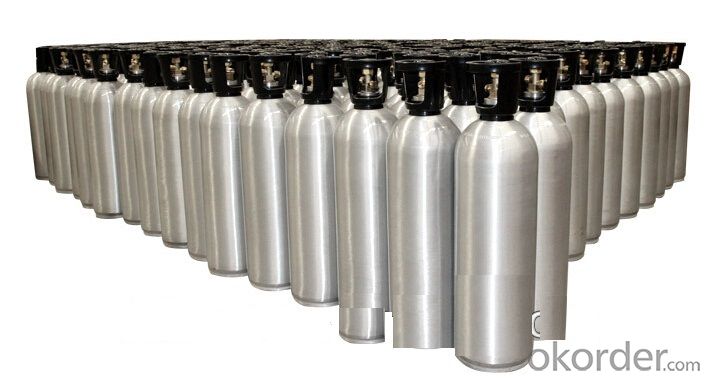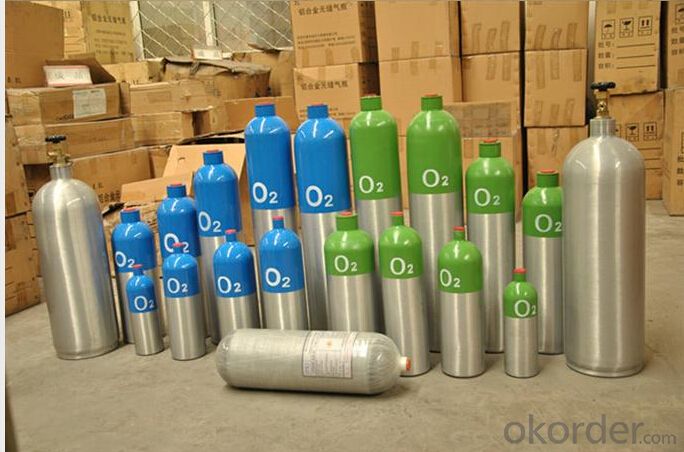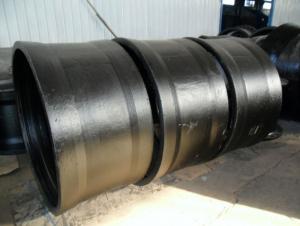Beverage Cylinders(CO2) Materia l: Aluminium
- Loading Port:
- Shanghai
- Payment Terms:
- TT OR LC
- Min Order Qty:
- 1 pc
- Supply Capability:
- 20000 pc/month
OKorder Service Pledge
OKorder Financial Service
You Might Also Like
Quick Details
Material: Aluminium
Use: Industrial Gas
Pressure: High
Place of Origin: Liaoning, China (Mainland)
Specifications
1.40%weight reduction than steel cylinders
2.clean and smelless cylinders
Beverage cylinders are made by aluminum 6061,with 40% weight reduction than steel cylinders unique interal and external treatments provide a superrior corrsion resistance assuring gases clean and smelless cylinders and made strictly to safety standardas all over the world,assuring acosistent and stable performance.High standard quality and detailed instruction for use and maintenance make sure safety operation and pertormance.

| Type | WaterCapacity(L) | OursideDiameter(mm) | Length(mm) | Wall Thickness(mm) | Net Weight(Kg) | ServicePressure(Mpa) |
| LWH60-0.6-15 | 0.6 | 60 | 332 | 4.0 | 0.8 | 15 |
| LWH75-0.7 -15 | 0.7 | 75 | 295 | 4.1 | 0.85 | 15 |
| LWH82-0.7 -15 | 0.7 | 82 | 235 | 4.2 | 0.9 | 15 |
| LWH89-0.5 -15 | 0.5 | 89 | 187 | 4.5 | 0.56 | 15 |
| LWH89- 0.7 -15 | 0.7 | 89 | 227 | 4.5 | 0.7 | 15 |
| LWH89- 1.0 -15 | 1.0 | 89 | 287 | 4.5 | 0.91 | 15 |
| LWH89- 1.4 -15 | 1.4 | 89 | 367 | 4.5 | 1.18 | 15 |
| LWH108-0.7 -15 | 0.7 | 108 | 169 | 5.5 | 1.1 | 15 |
| LWH108-1.0 -15 | 1.0 | 108 | 210 | 5.5 | 1.3 | 15 |
| LWH108- 1.4 -15 | 1.4 | 108 | 264 | 5.5 | 1.6 | 15 |
| LWH108-2.0 -15 | 2.0 | 108 | 365 | 5.6 | 2.2 | 15 |
| LWH108- 2.5 -15 | 2.5 | 108 | 433 | 5.6 | 2.6 | 15 |
| LWH120-2.8 -15 | 2.8 | 120 | 398 | 6.1 | 3.1 | 15 |
| LWH120-3.2 -15 | 3.2 | 120 | 437 | 6.1 | 3.5 | 15 |
| LWH140-4.0 -15 | 4.0 | 140 | 430 | 7.1 | 4.3 | 15 |
| LWH140-5.0 -15 | 5.0 | 140 | 507 | 7.1 | 5.1 | 15 |
| LWH140-6.0 -15 | 6.0 | 140 | 590 | 7.1 | 6.0 | 15 |
| LWH140-8.0 -15 | 8.0 | 140 | 745 | 7.1 | 7.7 | 15 |
| LWH159-10 -15 | 10 | 159 | 735 | 8.1 | 8.8 | 15 |
| LWH180-10 -15 | 10 | 180 | 605 | 9.1 | 10.1 | 15 |
| LWH203-12 -15 | 12 | 203 | 587 | 10.3 | 12.9 | 15 |
| LWH203-13.4 -15 | 13.4 | 203 | 640 | 10.3 | 13.8 | 15 |
| LWH203-20 -15 | 20 | 203 | 900 | 10.3 | 18.1 | 15 |
| LWH232-30 -15 | 30 | 232 | 1090 | 11.7 | 30.8 | 15 |
| LWH232-40 -15 | 40 | 232 | 1340 | 11.7 | 36.5 | 15 |
- Q: What is the bad effect of the engine oil pressure on the engine when the oil pressure is too high or too low?
- The pressure is too high, the hydraulic tappet internal rigidity is too large, it is easy to cause its door closed tight and so on, the pressure is too low, the hydraulic tappet internal rigidity is too small, will cause the valve clearance is too big. And aggravate wear. Note that this is only a one-sided phenomenon. In fact, when the oil pressure is unstable, the hydraulic tappet itself can compensate for the lack of pressure. I hope the above answer will help you.
- Q: Is it possible to change the hydraulic cylinder of the hydraulic lifting platform to the cylinder?
- As long as you can bore is large enough, the theory on the line! But in fact, considering space and other issues, you can not change it.
- Q: What is the working pressure of the hydraulic cylinder with a diameter of 80?
- See how you use it.. Let's do this
- Q: Multi axis drilling hydraulic system design of a horizontal cylinder in the machining production line (conditions: positioning, clamping hydraulic control, machine tool positioning clamping action sequence: - - - - - feeding slide fast forward rewind - stop - release - pull pin fixture, machine work axial cutting force 25000N, acceleration deceleration inertia force 500N 1500N, static friction resistance, friction resistance 850N, fast forward, rewind speed is 100mm/S and the feeding speed of 833mm/min, fast travel 0.1M of 0.04m. Worktable adopts flat guide rail)Tasks and requirements:Determine component specifications and complete hydraulic system loop diagram 1;2. Design the assembly drawing of the hydraulic cylinder 1;3, according to the prescribed format to complete the design, calculation manual 1.
- The design has to be replaced by moneyChange the design with a reward, dream!In addition, the use of hydraulic pressure to feed the power, can not guarantee a stable speed bar, careful processing tool was cracked
- Q: What is the cold drawn cylinder of a hydraulic cylinder? How about his quality? Master, help! Thank you
- Is the map in 4, the main advantages of the cold drawn pipe is the inner and outer dimension precision (tolerance) strictly, and surface roughness, roundness, straightness, uniform wall thickness, our company specializing in the production of hydraulic cylinder, the cylinder and the cylinder, the piston rod and its accessories, high quality and low price, welcome to buy
- Q: The difference between gas cylinder and cylinder
- The cylinder control is convenient, the price is low, the energy is easy to obtain, but the force is small, and can not achieve the effect of steady speed
- Q: Because I want to get a method to start the internal combustion cylinder (but not the cylinder cylinder, hydraulic cylinder like that, what I need is moving forward rather than rotating), but I have been unable to find this kind of cylinder, so would like to ask you that there is no real cylinder if there is? And can you tell me? If not, can the general cylinder and hydraulic cylinder internal combustion use? But I'm afraid of the inside of the rubber objects such as heat...Thank you!
- I don't want to say anything about it, but I'm sure you can tell that the cylinder doesn't make the cylinder burn
- Q: Why is the digital hydraulic cylinder not widely used?
- 2, hydraulic system plus flow flow valve; 3, do synchronous cylinder.
- Q: machinery and components, such as cylinders, cylinders and so on, whether the pressure vessel ah? Does the relevant manufacturer need relevant qualifications? FiveThere are two entirely different answers to the question. Which one is right? Hope that professionals pointing. Thank you
- Pressure is the airtight equipment that contains gas or liquid and carries certain pressureLiterally, the cylinders, cylinders, and hydraulic components are not airtight, with A, P and so on.. So it doesn't belong to the pressure vessel.
- Q: Compared with hydraulic cylinder and cylinder, what are the advantages of electric cylinder?
- The utility model has the advantages of low noise, energy saving, simple operation and maintenance, simple structure and low cost
Send your message to us
Beverage Cylinders(CO2) Materia l: Aluminium
- Loading Port:
- Shanghai
- Payment Terms:
- TT OR LC
- Min Order Qty:
- 1 pc
- Supply Capability:
- 20000 pc/month
OKorder Service Pledge
OKorder Financial Service
Similar products
Hot products
Hot Searches
Related keywords





















